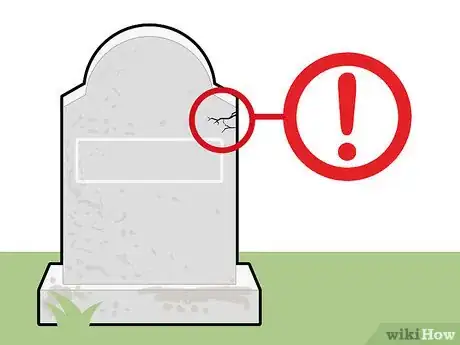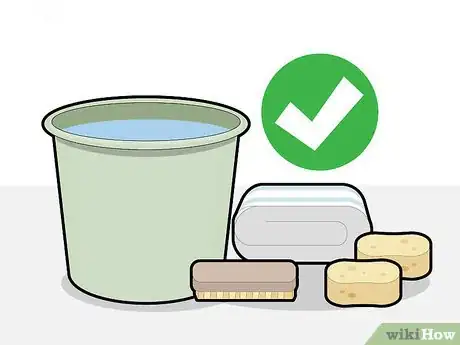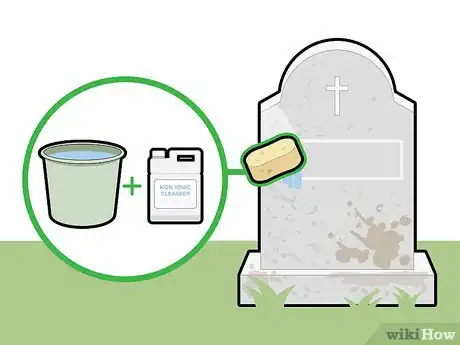This article was co-authored by wikiHow staff writer, Jessica Gibson. Jessica Gibson is a Writer and Editor who's been with wikiHow since 2014. After completing a year of art studies at the Emily Carr University in Vancouver, she graduated from Columbia College with a BA in History. Jessica also completed an MA in History from The University of Oregon in 2013.
There are 7 references cited in this article, which can be found at the bottom of the page.
wikiHow marks an article as reader-approved once it receives enough positive feedback. This article received 12 testimonials and 91% of readers who voted found it helpful, earning it our reader-approved status.
This article has been viewed 307,587 times.
Learn more...
We think of gravestones as lasting forever, but they do need to be cleaned occasionally and maintained. Fortunately, you can get a headstone to look its best with just a few basic cleaning supplies. In this article, we'll show you remove moss, lichen, and fungi from a gravestone with methods that are gentle, yet effective.
Things You Should Know
- Check the gravestone for cracking, flaking, or chipping before you begin cleaning. If the grave has any of these problems, it's not safe to clean.
- Use a gentle brush and water to scrub the surface of the gravestone. Never use harsh cleansers like bleach or liquid dish soap.
- Spray the gravestone a headstone cleaner like D/2 to remove lichen and moss. Let it dry on the surface or scrub the stone for immediate results.
Steps
Best Cleaning Techniques
-
1Clean gravestones to remove biological growth or stains. Consider whether the gravestone really needs it—after all, every gravestone develops a patina, which is a slight darkening that comes with age. Clean a gravestone if there's biological growth like algae, lichen, or fungi because these trap moisture and they're acidic, which can damage the stone.[1]
- If you see ivy, ferns, or moss growing over the headstone, it is a good idea to clean it. These plants also trap moisture and the roots can break up the stone.
- Wait to clean the gravestone until the weather is mild. If you decide to clean the headstone when it's very cold or excessively hot, the stone could crack when you clean it.[2]
-
2Check the gravestone for cracks, flaking, or chipping. Gently tap the surface of the gravestone and do not clean it if you hear a hollow sound—this is a sign that the interior of the stone isn't strong enough. Look at every side of the monument for damage like cracking, flaking, or excessive wearing since this means the stone is weak.[3]
- Do not clean a gravestone that's already broken or looks unstable. Gravestones can fall over and injure people, so be cautious when you're cleaning in a cemetery.
- If you're not a relative of the deceased, ask the family for permission or ask the cemetery for permission if you can't locate a family member.
Advertisement -
3Pour water over the stone to soak it thoroughly. You probably won't have an easy way to access water in most cemeteries, so plan on bringing at least 5 gallons (19 L) of water for each gravestone you plan on cleaning. Store the water in large jugs or put it in a low-pressure pump sprayer.[4]
- Never use an electric pressure washer on a gravestone since it will blast off the surface of the stone.
-
4Scrape off lichen, moss, and fungi with a plastic scraper. Press the scraper onto the surface gravestone and gently scrape from the top to the bottom. You don't have to press very hard to get the biological growth to fall away. To get lichen or moss out from carved letters or images on the stone, take a wooden popsicle stick or a bamboo skewer and scrape the material out.[5]
- If you don't have a plastic scraper, use a wooden scraper. While it might be tempting to reach for a metal tool, metal is too abrasive and it could scratch the surface of the headstone.
- If there are vines or plants growing over the headstone, don't pull them out or you could damage the gravestone. Instead, cut the plants down to the ground and wait a few weeks until they die. Then, gently pull the dried plant out of the soil.
-
5Scrub the surface of the gravestone with a soft bristle brush. Dip the brush in water and gently scrub near the bottom of the gravestone to loosen the grime. If you're cleaning marble or limestone, use a sponge that's even gentler than a soft bristle brush. Work in a circular motion and don't press hard—even gentle contact with the stone will contribute to wear, especially for marble and limestone. Keep scrubbing up until you reach the top of the gravestone. Repeat this for each side.[6]
- It might seem counterintuitive to clean from bottom to top, but working this way prevents limescale from forming.
- To remove graffiti, work fast and clean the stone as soon as possible. Dip a soft bristle brush in water and scrub the gravestone. If the graffiti doesn't come off, spray D/2, a non-ionic cleanser, on the stone and scrub with a brush.
-
6Apply a non-ionic cleanser like D/2 to remove tough stains. If you're unhappy with how much grime is still on the gravestone, spray undiluted D/2 over the entire surface of the stone—this cleanser doesn't contain harsh salts that can damage gravestones. To get immediate results, let the product sit for 5 to 10 minutes before spraying it again. Then, scrub the stone with a gentle brush before you rinse it with plain water.[7]
- Because non-ionic cleansers continue to work after you've applied them, you can spray the stone and simply let it air dry. When you come back weeks or months later, you'll be surprised at the improvement!
-
7Rinse the gravestone with plain water. Once you've scrubbed the surface or finished using a non-ionic cleanser, pour water over the entire stone to rinse away grime and debris. Remember, you're trying to remove grime and organisms that could damage the gravestone—don't worry if it doesn't look pristine. You've looked after the gravestone and prevented further damage.[8]
-
8Work with the most gentle tools and cleaning agents. It's hard to overstate how important it is to do no harm. It's really easy to accidentally be too rough on old, weathered stone. Here are a few things you should never use to clean a gravestone:[9]
- Bleach or chlorine
- Vinegar or acidic cleansers
- Metal tools, wire scrub brushes, or abrasive pads
- Household cleansers like dish soap or detergents
- Pressure washers or sandblasters
Care and Maintenance
-
1Clean a gravestone every 4 to 6 years to prevent excess wear. It might surprise you to hear that gravestones shouldn't be cleaned often. In fact, some experts recommend waiting 4 to 6 years in between cleanings![10] This prevents frequent wear from weakening the stone.
- Write down the date you clean the gravestone so you can refer back to when you last cleaned it.
- If the cemetery provides regular maintenance, ask them about how often they clean the gravestone.
-
2Clear the growth around the gravestone. Use loppers or a weed eater to cut back trees and vines that are growing over the gravestone, as well as any plants that make it hard for cemetery workers to mow around the stone.[11]
- Although lilacs, roses, or hardwood trees make lovely additions to a cemetery, if they're too close to to the headstone, their roots can damage the stone.
- Ask the cemetery for permission before you remove plants. They might have a groundskeeper that can clear the area of growth for you.
-
3Leave flowers or memorial tokens if you'd like to honor a loved one. Ask the cemetery about their regulations before you decorate a grave site. If allowed, you might leave flowers, a candle, or a token that represents something your loved one enjoyed.[12]
- Many people leave special tokens of remembrance on holidays, anniversaries, or birthdays.
Community Q&A
-
QuestionI heard you can put a little shine on a grave marker by wiping it with baby oil. Yes or no?
 Noneya FrigginbezwaxCommunity AnswerFrom what I've read, I get the impression that this is something you should avoid, as stone is porous and will absorb like a sponge. It may look great for the short term, but it may also cause damage and accelerate the wear and tear on the stone and engraving.
Noneya FrigginbezwaxCommunity AnswerFrom what I've read, I get the impression that this is something you should avoid, as stone is porous and will absorb like a sponge. It may look great for the short term, but it may also cause damage and accelerate the wear and tear on the stone and engraving. -
QuestionCan I use household bleach to wipe down a headstone?
 Noneya FrigginbezwaxCommunity AnswerNo. Bleach should never be used on a tombstone or similar stone monument or statue. Stone is porous and will absorb the bleach/salt, and it will crystalize and cause more damage than the moss and lichen on the stone already.
Noneya FrigginbezwaxCommunity AnswerNo. Bleach should never be used on a tombstone or similar stone monument or statue. Stone is porous and will absorb the bleach/salt, and it will crystalize and cause more damage than the moss and lichen on the stone already. -
QuestionCan Ivory dish soap mixed with water be used to clean marble?
 Noneya FrigginbezwaxCommunity AnswerI have been reading on several tombstone conservation sites, and no soaps or detergents should be used. Stone is porous and will absorb like a sponge, and there are ingredients in most soaps/detergents that will cause damage to the stone. Currently a product called D/2 is recommended, and is the cleaning agent used on the White House and various statues and monuments. The most gentle way to clean is to spray it on and allow mother nature to do the rest, since the more you agitate the stone, the more wear you cause on the stone and fine edges of the engraving. If you have a build up of lichen and moss, you can use a toothpick, tongue depressor, or paint stir sticks to remove the bulk of it.
Noneya FrigginbezwaxCommunity AnswerI have been reading on several tombstone conservation sites, and no soaps or detergents should be used. Stone is porous and will absorb like a sponge, and there are ingredients in most soaps/detergents that will cause damage to the stone. Currently a product called D/2 is recommended, and is the cleaning agent used on the White House and various statues and monuments. The most gentle way to clean is to spray it on and allow mother nature to do the rest, since the more you agitate the stone, the more wear you cause on the stone and fine edges of the engraving. If you have a build up of lichen and moss, you can use a toothpick, tongue depressor, or paint stir sticks to remove the bulk of it.
Warnings
- If the stone begins to flake or gritty bits of stone shed as you clean, stop cleaning immediately because the stone isn't stable enough to work with.[14]⧼thumbs_response⧽
Things You'll Need
- Container for water
- Plastic scraper
- Low-pressure pump sprayer
- Soft bristle brush
- Non-ionic biological cleanser like D/2
- Loppers or weed eater
- Natural sponge
- Wooden popsicle stick or bamboo skewer, optional
References
- ↑ http://chicora.org/cleaning.html
- ↑ http://chicora.org/cleaning.html
- ↑ https://www.oregon.gov/oprd/OH/Documents/HB03_How_to_Clean_Markers.pdf
- ↑ http://sites.rootsweb.com/~nychauta/CEMETERY/Highland/CleaningAGravestone.html
- ↑ http://chicora.org/cleaning.html
- ↑ http://www.nhoga.com/preservation.htm
- ↑ http://www.colchesterhistoricalsociety.org/PDF%20FIles/Headstone%20Cleaning%20with%20D2.pdf
- ↑ https://www2.illinois.gov/dnrhistoric/Preserve/Cemetery/SiteAssets/Pages/default/Cleaning%20Grave%20Markers.pdf
- ↑ http://sites.rootsweb.com/~nychauta/CEMETERY/Highland/CleaningAGravestone.html
- ↑ https://www.oregon.gov/oprd/OH/Documents/HB03_How_to_Clean_Markers.pdf
- ↑ http://www.nhoga.com/preservation.htm
- ↑ https://www.ci.claremont.ca.us/government/departments-divisions/community-services/oak-park-cemetery/gravesite-decoration-guidelines
- ↑ http://www.nhoga.com/preservation.htm
- ↑ http://www.colchesterhistoricalsociety.org/PDF%20FIles/Headstone%20Cleaning%20with%20D2.pdf
About This Article
Before you clean a gravestone, buy a mild, gentle soap or a non-ionic soap. Next, mix your soap with water and dampen a sponge with the solution. Then, gently wipe down the surface of the stone with the sponge, using a brush for the tougher dirt. If there’s any natural growth on the stone, like lichen, mix 1 part ammonia with 4 parts water and use a sponge to scrub the affected area. Aim to clean the gravestone once every 18-24 months, or as needed. To learn how to choose the right type of stone for a grave, keep reading.










































































